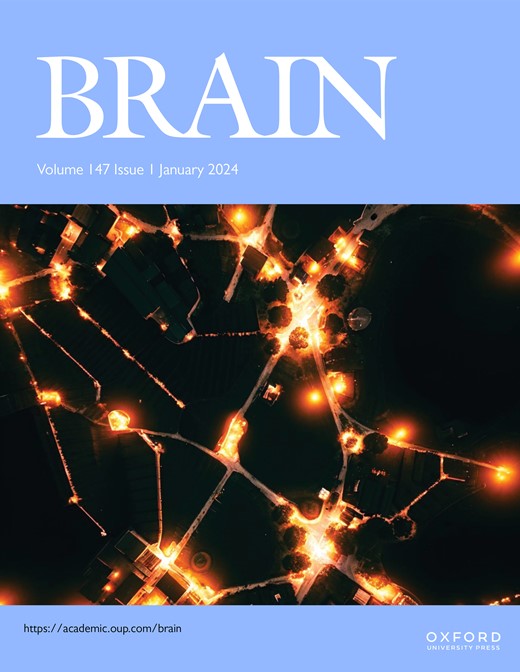运动神经元中 MBNL 的缺乏会破坏神经肌肉接头的维持和步态协调
IF 10.6
1区 医学
Q1 CLINICAL NEUROLOGY
引用次数: 0
摘要
肌球蛋白样蛋白(MBNLs)是一个 RNA 结合蛋白家族,在 RNA 代谢调控中发挥着重要作用。除了在 RNA 调节中的典型作用外,MBNL 蛋白还是 1 型肌营养不良症(DM1)发病机制中的关键角色。在 DM1 中,由于 CUG 重复 RNA 的扩增导致 MBNL 蛋白被螯合,从而导致 MBNL 的功能耗竭,造成替代剪接失调和 RNA 处理失常,这也是该疾病临床特征的基础。尽管人们对 MBNL 蛋白的关注主要集中在它们在骨骼肌中的功能上,但新的证据表明,它们的重要性延伸到了运动神经元(MNs)上,MNs 是控制运动技能和运动的关键细胞成分。为了解决这个问题,我们产生了条件性双基因敲除小鼠,在运动神经元中特异性地删除了 Mbnl1 和 Mbnl2(MN-dKO)。成年的 MN-dKO 小鼠会出现步态协调障碍,并伴有神经肌肉接头的结构和超微结构缺陷,这表明运动神经元中的 MBNL 活性对神经肌肉接头的维持至关重要。此外,对 MN-dKO 小鼠脊髓进行的转录组分析还发现了与突触传递和神经肌肉接头稳态相关的基因的错误剪接事件。总之,我们的研究结果突显了 MBNL 蛋白在 MNs 肌肉功能和运动中的复杂作用和调控机制。这项工作为 RNA 生物学的基本方面提供了有价值的见解,并为治疗干预 DM1 以及一系列与 RNA 失调相关的疾病提供了有希望的途径。本文章由计算机程序翻译,如有差异,请以英文原文为准。
MBNL deficiency in motor neurons disrupts neuromuscular junction maintenance and gait coordination
Muscleblind-like proteins (MBNLs) are a family of RNA-binding proteins that play essential roles in the regulation of RNA metabolism. Beyond their canonical role in RNA regulation, MBNL proteins have emerged as key players in the pathogenesis of Myotonic Dystrophy type 1 (DM1). In DM1, sequestration of MBNL proteins by expansion of the CUG repeat RNA leads to functional depletion of MBNL, resulting in deregulated alternative splicing and aberrant RNA processing, which underlie the clinical features of the disease. While attention to MBNL proteins has focused on their functions in skeletal muscle, new evidence suggests that their importance extends to motor neurons (MNs), pivotal cellular components in the control of motor skills and movement. To address this question, we generated conditional double knockout mice in which Mbnl1 and Mbnl2 were specifically deleted in motor neurons (MN-dKO). Adult MN-dKO mice develop gait coordination deficits associated with structural and ultrastructural defects in the neuromuscular junction, indicating that MBNL activity in MNs is crucial for the maintenance of the neuromuscular junction. In addition, transcriptome analysis performed on the spinal cord of MN-dKO mice identified mis-splicing events in genes associated with synaptic transmission and neuromuscular junction homeostasis. In summary, our results highlight the complex roles and regulatory mechanisms of MBNL proteins in MNs for muscle function and locomotion. This work provides valuable insights into fundamental aspects of RNA biology and offers promising avenues for therapeutic intervention in DM1 as well as a range of diseases associated with RNA dysregulation.
求助全文
通过发布文献求助,成功后即可免费获取论文全文。
去求助
来源期刊

Brain
医学-临床神经学
CiteScore
20.30
自引率
4.10%
发文量
458
审稿时长
3-6 weeks
期刊介绍:
Brain, a journal focused on clinical neurology and translational neuroscience, has been publishing landmark papers since 1878. The journal aims to expand its scope by including studies that shed light on disease mechanisms and conducting innovative clinical trials for brain disorders. With a wide range of topics covered, the Editorial Board represents the international readership and diverse coverage of the journal. Accepted articles are promptly posted online, typically within a few weeks of acceptance. As of 2022, Brain holds an impressive impact factor of 14.5, according to the Journal Citation Reports.
 求助内容:
求助内容: 应助结果提醒方式:
应助结果提醒方式:


